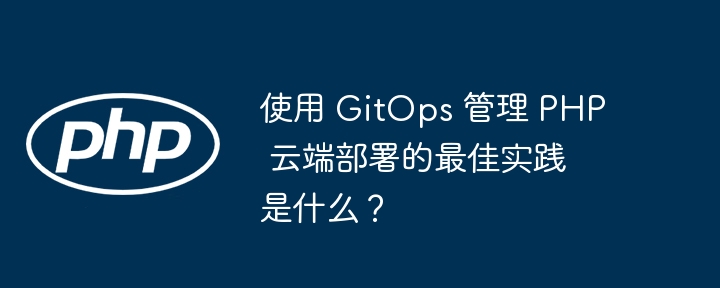
Best practices for using GitOps to manage PHP cloud deployments include: Using Git as the only source of configuration to maintain consistency and reduce errors. Create a GitOps pipeline, including build, test, and deploy steps. Use CI/CD tools to automate deployments and allow teams to focus on development tasks. Specify desired state, simplify changes and ensure consistency using declarative deployment technology. Use canary deployment to gradually update the production environment to reduce the impact and risk on users.

Best practices for using GitOps to manage PHP cloud deployment
GitOps is a combination of Git version control and continuous deployment DevOps practices. It enables development teams to automate cloud deployments using Git pipelines, increasing deployment speed and reliability. The following are some best practices for using GitOps to manage PHP cloud deployments:
1. Use Git as the only source of configuration
Git should be used as the only source of configuration, including deployment files , code and environment variables. This ensures consistent configuration across teams and reduces errors.
2. Create a GitOps pipeline
Create a GitOps pipeline to deploy code changes from the Git warehouse to the cloud environment. The pipeline should include the following steps:
- build: 构建 PHP 应用程序 - test: 运行单元和集成测试 - deploy: 将应用程序部署到云端
3. Use CI/CD tools
Use CI/CD tools such as Jenkins or GitLab CI to trigger the pipeline and execute automation deploy. This allows teams to focus on development tasks while leaving deployment automation to CI/CD tools.
4. Use declarative deployment
Use declarative deployment technology, such as Kubernetes, to specify the state required for application configuration and deployment. Declarative deployment enables teams to easily make configuration changes and ensure deployment consistency.
5. Use canary deployment
Use canary deployment to gradually deploy new code into production. This helps identify and fix any issues in the deployment while minimizing impact on the production environment.
Practical case
Use GitHub Actions and Kubernetes for PHP application GitOps deployment:
.github/workflows directory. Configure the following steps in the workflow file:
Conclusion
Using GitOps to manage PHP cloud deployments provides many benefits, including increased deployment speed, reliability, and scalability. By following these best practices, teams can effectively manage their deployments and focus on delivering high-quality software.
The above is the detailed content of What are the best practices for managing PHP cloud deployments using GitOps?. For more information, please follow other related articles on the PHP Chinese website!